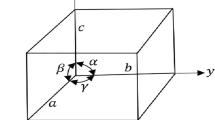Abstract
Using area detectors for stress determination by diffraction methods in a single exposure greatly simplifies the measurement process and permits the design of portable systems without complex sample cradles or moving parts. An additional advantage is the ability to see the entire or a large fraction of the Debye ring and thus determine texture and grain size effects before analysis. The two methods most commonly used to obtain stress from a single Debye ring are the so-called \(\cos \alpha \) and full-ring fitting methods, which employ least-squares procedures to determine the stress from the distortion of a Debye ring by probing a set of scattering vector simultaneously. The widely applied \(\sin ^2\psi \) method, in contrast, requires sample rotations to probe a different subset of scattering vector orientations. In this paper, we first present a description of the different methods under the same formalism and using a unified set of coordinates that are suited to area detectors normal to the incident beam, highlighting the similarities and differences between them. We further characterize these methods by means of in situ measurements in carbon steel tube samples, using a portable detector in reflection geometry. We show that, in the absence of plastic flow, the different methods yield basically the same results and are equivalent. An analysis of possible sources of errors and their impact in the final stress values is also presented.









Similar content being viewed by others
References
Heindlhofer K (1948) Evaluation of residual stress. McGraw-Hill Book Co., New York
Barrett CS (1952) Structure of metals. McGraw-Hill Book Co., New York
Taylor A (1961) X-ray metallography. Wiley, New York
Homicz RJ (1967) Fundamentals and basic techniques of residual stress measurements with a portable x-ray diffraction unit. Soc Automot Eng Trans 76(s1):912–917
James MR, Cohen JB (1978) The measurement of residual stresses by x-ray diffraction techniques. Treatise on materials science and technology, vol 19A. Academic, New York, pp 1–62
Gelfi M, Bontempi E, Roberti R, Depero L (2004) X-ray diffraction debye ring analysis for stress measurement (DRAST): a new method to evaluate residual stresses. Acta Mater 52(3):583–589
He BB (2011) Two-dimensional X-ray diffraction. Wiley, Hoboken
Noyan IC, Cohen JB (1987) Residual stress. Springer, New York
Hauk V (1997) Structural and residual stress analysis by nondestructive methods: evaluation-application-assessment. Elsevier, Amsterdam
Ling J, Lee S-Y (2015) Characterization of a portable x-ray device for residual stress measurements. Adv X-ray Anal 59:153–161
Boyce B, Furnish T, Padilla H II, Van Campen D, Mehta A (2015) Detecting rare, abnormally large grains by x-ray diffraction. J Mater Sci 50:6719–6729. doi:10.1007/s10853-015-9226-3
Ramirez-Rico J, Stolzenburg F, Almer J, Routbort J, Singh D, Faber K (2013) In situ imaging and strain determination during fracture in a sic/sic ceramic matrix composite. Scripta Mater 69(7):497–500
Harder BJ, Ramirez-Rico J, Almer JD, Lee KN, Faber KT (2011) Chemical and mechanical consequences of environmental barrier coating exposure to calcium-magnesium-aluminosilicate. J Am Ceram Soc 94:s178–s185
Sasaki T, Hirose Y, Sasaki K, Yasukawa S (1997) Influence of image processing conditions of debye Scherrer ring images in x-ray stress measurement using an imaging plate. Adv X-ray Anal 40:588–594
Sasaki T, Kobayashi Y (2009) X-ray multiaxial stress analysis using two debye rings. Adv X-ray Anal 52:248–255
Sasaki T, Maruyama Y, Ohba H, Ejiri S (2014) Two-dimensional imaging of debye-Scherrer ring for tri-axial stress analysis of industrial materials. J Instrum 9:C07066
Kampfe A, Kampfe B, Goldenbogen S, Eigenmann B, Macherauch E, Lohe D (2000) X-ray stress analysis on polycrystalline materials using two-dimensional detectors. Adv X-ray Anal 43:54–65
Behnken H, Hauk V (2001) Determination of steep stress gradients by x-ray diffraction-results of a joint investigation. Mater Sci Eng A 300(1):41–51
Marques M, Dias A, Gergaud P, Lebrun J (2000) A methodology development for the study of near surface stress gradients. Mater Sci Eng A 287(1):78–86
Dolle H (1979) The influence of multiaxial stress states, stress gradients and elastic anisotropy on the evaluation of (residual) stresses by x-rays. J Appl Crystallogr 12(6):489–501
Taira S, Tanaka K, Yamazaki T (1978) A method of x-ray microbeam measurement of local stress and its application to fatigue crack growth problems. J Soc Mater Sci Jpn 27(294):251–256
Chidambarrao D, Song Y, Noyan I (1997) Numerical simulation of the x-ray stress analysis technique in polycrystalline materials under elastic loading. Metall Mater Trans A 28(12):2515–2525
Noyan I, Nguyen L (1988) Oscillations in interplanar spacing vs. sin2\(\psi \) a fem analysis. Adv X-ray Anal 31:191–204
Noyan I, Nguyen L (1989) Effect of plastic deformations on oscillations in \(d\) vs. \(\sin ^2\psi \) plots. Adv X-ray Anal 32:355–364
Noyan I, Cohen J (1983) Determining stresses in the presence of nonlinearities in interplanar spacing vs. \(\sin ^2\psi \). Adv X-ray Anal 27:129–148
Hounkpati V, Fréour S, Gloaguen D, Legrand V (2014) Influence of morphologic texture on stress analysis by x-ray and neutron diffraction in single-phase metallic materials. J Mater Sci 49(20):7049–7065. doi:10.1007/s10853-014-8410-1
Acknowledgements
Loading experiments were performed at the Robert W. Carleton Strength of Materials Laboratory, Columbia University. Dr. A. Brügger’s assistance with the loading setup is gratefully acknowledged. The X-ray portable stress measurement device was kindly supplied by Pulstec Industrial Co., Ltd. The authors would like to thank Toshikazu Suzuki and Yoshinobu Teramoto for installation and technical support. J. Ramirez-Rico gratefully acknowledges the support from the Universidad de Sevilla Research Fund (V Plan Propio).
Author information
Authors and Affiliations
Corresponding author
Ethics declarations
Conflict of interest
The authors declare that they have no conflict of interest.
Electronic supplementary material
Below is the link to the electronic supplementary material.
Rights and permissions
About this article
Cite this article
Ramirez-Rico, J., Lee, SY., Ling, J.J. et al. Stress measurement using area detectors: a theoretical and experimental comparison of different methods in ferritic steel using a portable X-ray apparatus. J Mater Sci 51, 5343–5355 (2016). https://doi.org/10.1007/s10853-016-9837-3
Received:
Accepted:
Published:
Issue Date:
DOI: https://doi.org/10.1007/s10853-016-9837-3




